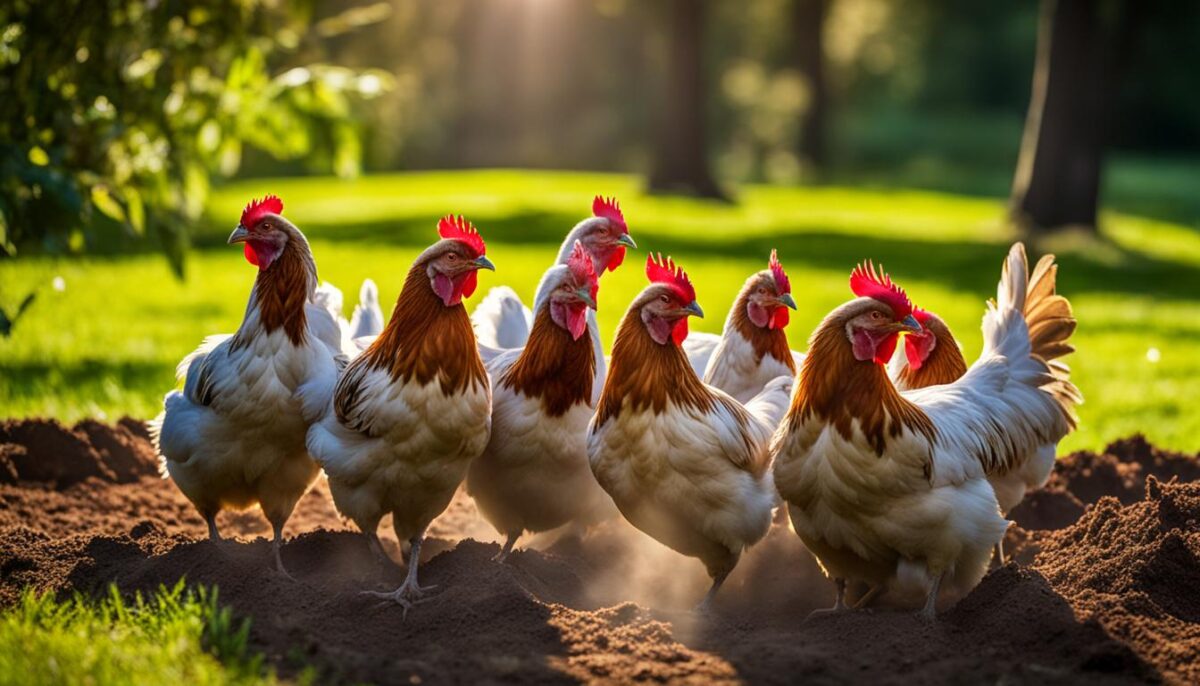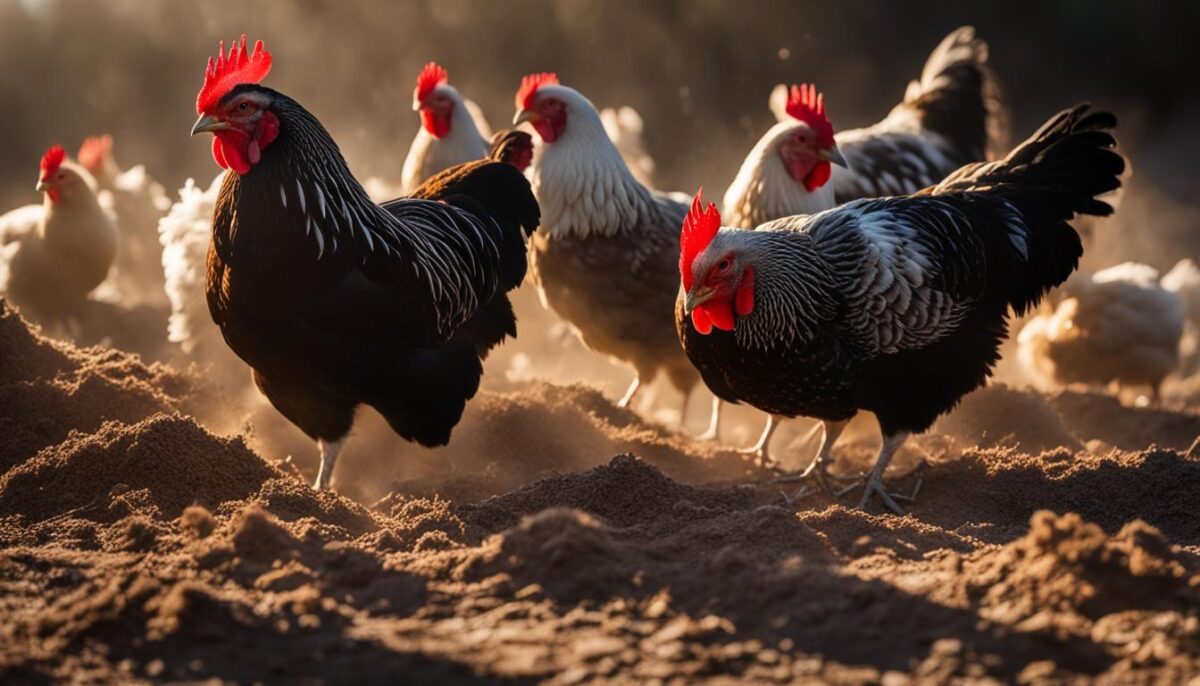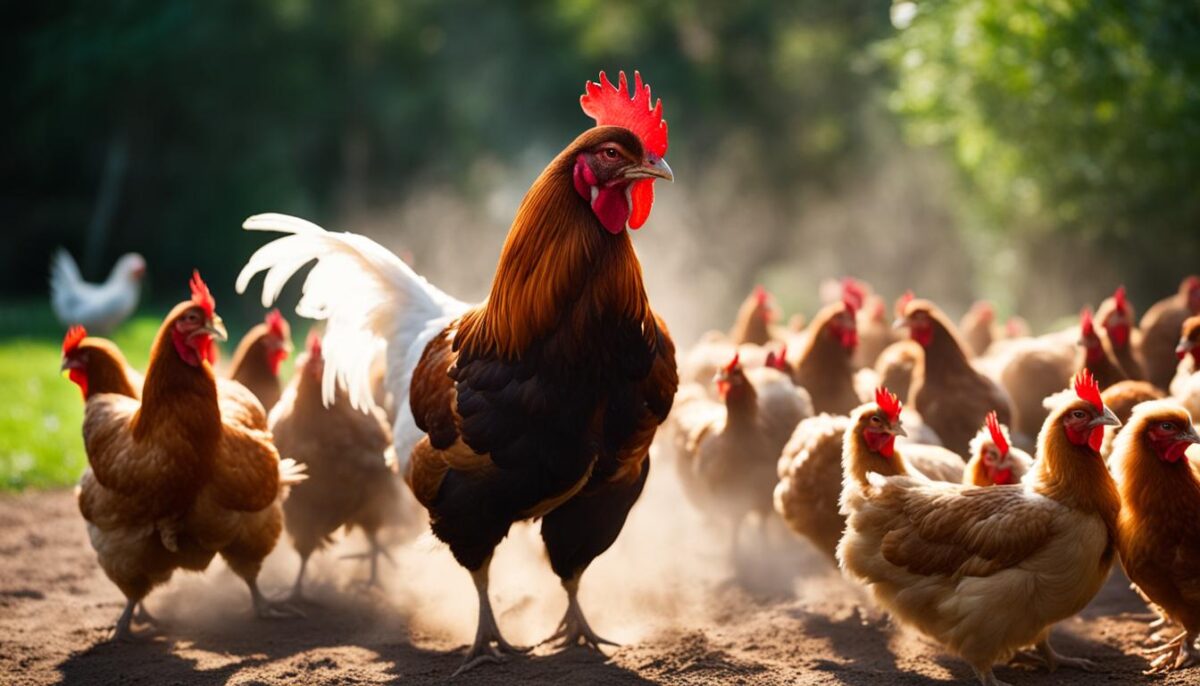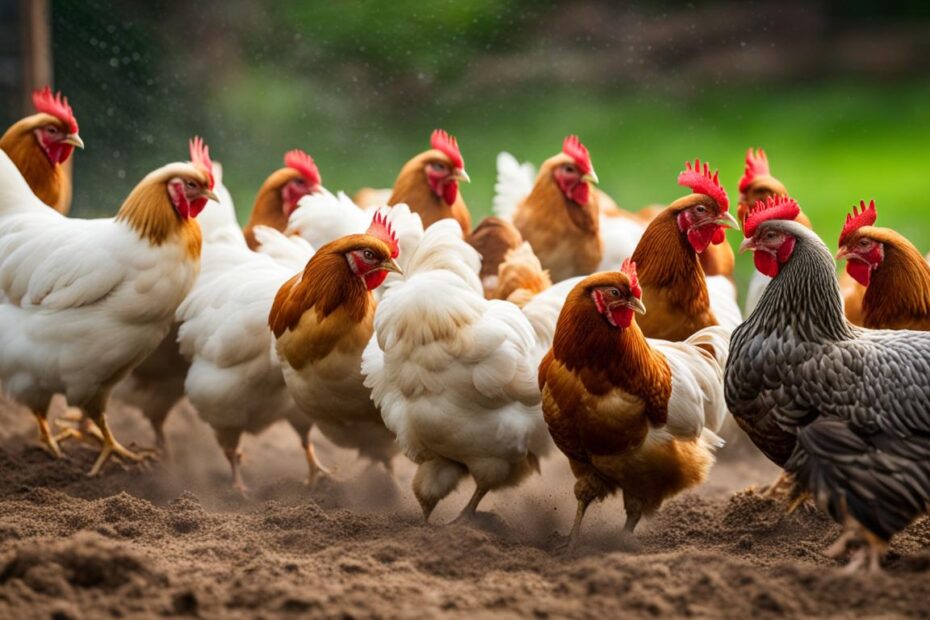Birds engage in various behaviors to keep themselves clean and healthy, including dust bathing. But why do chickens, in particular, have a natural instinct to roll in dirt? Let’s delve into the fascinating world of chicken behavior and uncover the benefits of dust bathing for their grooming and health.
Key Takeaways:
- Chickens roll in dirt as a natural instinct and behavior known as dust bathing.
- Dust bathing helps chickens maintain their hygiene by removing excess oil, dirt, and parasites from their feathers and skin.
- Regular dust bathing is essential for preventing parasites and promoting overall chicken health.
- Dust bathing behavior is not limited to chickens and is observed in many avian species.
- Understanding dust bathing provides insights into the remarkable ways birds have adapted to maintain their cleanliness and well-being.
Understanding Bird Bathing Behavior
Birds engage in various bathing methods as part of their hygiene routines, including dusting and water bathing. Dusting involves birds fluffing their feathers and rubbing themselves with dust or sand to remove excess oil, dirt, and parasites. Water bathing, on the other hand, involves birds submerging themselves in water to clean their feathers and skin. Both dusting and water bathing are essential parts of avian hygiene practices.
Dusting and water bathing serve different purposes for birds. Dusting is especially useful for removing excess oil and dirt from the feathers, as well as eliminating parasites that may be present. By fluffing their feathers and rubbing the dust or sand into their plumage, birds can dislodge and remove unwanted particles. This behavior helps to keep their feathers clean, functional, and well-insulated.
Water bathing, on the other hand, is beneficial for overall cleanliness and hygiene. By submerging themselves in water, birds can wet their feathers, allowing water to penetrate through the plumage and reach the skin. This helps to dislodge any remaining dirt or debris that may not have been removed through dusting alone. Additionally, water bathing can also assist in the preening process, as birds use their beaks to distribute oil produced by the preen gland across their feathers, keeping them waterproof and in good condition.
Bird Bathing Methods
There are various ways in which birds engage in bathing behaviors. Some species prefer to dust themselves in dry, sandy areas, while others may opt for moist soil or mud. Certain birds, such as herons or ducks, engage in water bathing by swimming or floating in bodies of water, while others prefer shallow pools or even rainwater puddles. The specific bathing methods vary among different bird species and depend on factors such as habitat, availability of suitable bathing areas, and individual preferences.
| Bird Species | Bathing Method |
|---|---|
| Sparrows | Dry dusting in sandy areas |
| Robins | Water bathing in shallow pools |
| Swans | Water bathing by swimming in lakes |
| Pigeons | Dry dusting on buildings or rooftops |
Types of Bird Dusting Habits
Birds exhibit a variety of dusting habits, which can vary depending on their species and environmental conditions. Understanding these different types of dusting habits can provide insights into the diverse behaviors and adaptations of avian species.
Dry Dusting
One common type of dusting habit is known as dry dusting. This involves birds fluffing their feathers and then vigorously rubbing themselves with dry dust or sand. The abrasive texture of the dust or sand helps to remove excess oil, dirt, and parasites from the feathers and skin. Dry dusting is frequently observed in birds that live in arid or sandy environments.
Wet Dusting
Another type of dusting habit is wet dusting, which involves birds using moist soil or mud for their dust baths. Wet dusting is especially common in areas where water is scarce. Birds will create shallow depressions in the damp soil or mud, then flop into the wet mixture and vigorously flap their wings, allowing the moisture to penetrate their feathers and aid in the removal of dirt and parasites.
Dusting in Groups
Some bird species have also been observed engaging in dusting behavior as a group. This communal dusting can occur in specific areas where the conditions are favorable for dust bathing. Birds will gather in these areas and take turns dusting, creating a social activity that also helps to maximize the benefits of dusting for each individual.
By displaying a range of dusting habits, birds adapt their grooming behaviors to suit their specific environments and needs. Whether through dry dusting, wet dusting, or dusting in groups, the purpose remains the same: to maintain the health and cleanliness of their feathers and skin.
The Science Behind Dust Bathing
Avian hygiene practices, including dust bathing, are guided by the natural instincts of birds and serve important purposes in maintaining their health and cleanliness. Dust bathing, observed in numerous bird species, involves birds covering themselves in dust or sand to remove excess oil, dirt, and parasites from their feathers and skin. This behavior not only helps with grooming but also plays a role in maintaining overall feather health and functionality.
Dust bathing serves as a form of avian hygiene by removing parasites that may be present on the bird’s body. As birds roll in the dust, the particles adhere to their feathers and penetrate into hard-to-reach areas, dislodging any parasites or debris that may be clinging to the feathers. This process helps to prevent infestations and keep the birds free from harmful external parasites.
In addition to removing parasites, dust bathing also aids in feather maintenance. As birds roll in the dust, the particles help to clean and condition the feathers. The abrasive nature of the dust particles assists in removing excess oil and dirt that may have accumulated on the feathers, ensuring that they remain clean and functional. Clean feathers are essential for effective flight, insulation, and waterproofing.
| Benefits of Dust Bathing | Explanation |
|---|---|
| Parasite Control | Dust bathing helps remove parasites from the bird’s body, preventing infestations. |
| Feather Maintenance | The abrasive nature of the dust particles helps clean and condition the feathers. |
| Body Temperature Regulation | The dust particles can help regulate body temperature by absorbing excess moisture and preventing heat loss. |
The science behind dust bathing highlights the importance of this behavior in avian species. By engaging in this instinctual behavior, birds can effectively clean themselves, maintain healthy feathers, and prevent parasite infestations. Understanding the science behind avian hygiene practices allows us to appreciate the remarkable adaptations that birds have developed to ensure their cleanliness and well-being.
Benefits of Dirt Baths for Birds
Dirt baths offer numerous benefits for birds, contributing to their overall health and well-being. Let’s explore some of the key advantages of this natural grooming behavior:
Parasite Control
One of the primary benefits of dirt baths for birds is parasite control. When birds roll in dirt or sand, these abrasive substances help dislodge and remove parasites such as lice, mites, and ticks that may be present in their feathers or on their skin. By regularly engaging in dirt baths, birds can keep these harmful parasites at bay, reducing the risk of infestations and related health issues.
Feather Maintenance
Dirt baths also play a crucial role in maintaining the quality of birds’ feathers. When birds roll in dirt, the abrasive particles help to remove excess oil and dirt that can accumulate on their feathers over time. This natural cleaning process helps to keep feathers clean, functional, and insulating, crucial for maintaining body temperature and facilitating flight.
Body Temperature Regulation
In addition to parasite control and feather maintenance, dirt baths may also aid in regulating body temperature for birds. The fine particles of dirt or sand that coat the feathers can provide insulation, helping birds to stay warm in cool weather and prevent overheating in hot conditions. By utilizing dirt baths as a means of temperature regulation, birds can adapt to changing environmental conditions and maintain their comfort.
Overall, dirt baths are an essential part of a bird’s grooming routine, providing vital benefits such as parasite control, feather maintenance, and body temperature regulation. By engaging in this natural behavior, birds can ensure their cleanliness, health, and long-term survival in their respective habitats.

Why Do Some Birds Roll in the Dust?
While many bird species engage in dust bathing, some take it a step further by rolling in the dust. Rolling in the dust allows the dust to penetrate deeper into their feathers, reaching areas that a simple dust bath may not. This helps to dislodge any parasites or debris that may be stuck, providing a more thorough cleaning. Rolling in the dust also stimulates the preen gland, which secretes oil that birds spread across their feathers during preening.
Rolling in the dust is a behavior commonly observed in birds, particularly those that inhabit arid environments. It serves as an efficient method for cleaning hard-to-reach areas and maintaining overall feather health. By rolling, birds ensure that not only the outermost feathers but also the downy underfeathers are thoroughly cleaned and well-maintained. This action helps to prevent the accumulation of dirt, oil, or parasites, which could compromise the bird’s health and feather functionality.
“Rolling in the dust allows birds to engage in a comprehensive grooming process, ensuring that their feathers remain clean, well-maintained, and functional.”
Additionally, rolling in the dust stimulates the preen gland, located at the base of the bird’s tail. This gland produces oil that the bird spreads across its feathers during preening. The oil serves as a natural conditioner, keeping the feathers flexible and resistant to water absorption. By stimulating the preen gland, birds ensure that their feathers retain their waterproof properties, preventing them from becoming waterlogged and reducing insulation abilities.
The Science Behind Dust Bathing
The act of dust bathing, including rolling in the dust, is deeply ingrained in the natural instincts of birds. It has evolved as an effective mechanism for maintaining their cleanliness, removing parasites, and preserving the functionality of their feathers. By understanding the science behind dust bathing, we gain insight into the fascinating ways in which birds have adapted to prioritize their hygiene and overall well-being.
The Hygiene Practices of Avian Species
As a passionate birdwatcher, I have observed that avian species have unique hygiene practices that set them apart from other animals. Birds have evolved various ways to maintain their cleanliness and overall health, which include dust bathing, preening, and water bathing. These behaviors are crucial for their well-being and play a significant role in avian hygiene practices.
Avian Hygiene Practices:
- Dust Bathing: Birds engage in dust bathing by rolling in dirt or sand. This behavior helps them remove excess oil, dirt, and parasites from their feathers and skin. Dust bathing is an essential part of avian grooming and contributes to bird health.
- Preening: Birds engage in preening to clean and maintain their feathers. They use their beaks to carefully align and condition their feathers, ensuring insulation, functionality, and overall feather maintenance.
- Water Bathing: Water bathing is another common avian hygiene practice. Birds submerge themselves in water, which helps to clean their feathers and skin. It is especially important for removing any residual dust or dirt particles after dust bathing.
By engaging in these hygiene practices, birds can keep their feathers and skin clean, healthy, and free from parasites. These behaviors are deeply rooted in their natural instincts and have evolved over time to ensure their survival in various habitats.
| Avian Hygiene Practices | Benefits |
|---|---|
| Dust Bathing |
|
| Preening |
|
| Water Bathing |
|
Avian hygiene practices, including dust bathing, preening, and water bathing, are essential for birds to maintain their cleanliness, overall health, and survival. These behaviors are instinctual and have evolved over time, allowing birds to adapt to various environments and stay free from parasites and other health risks.
Understanding and appreciating the hygiene practices of avian species can help us protect and conserve their habitats. By recognizing the importance of these behaviors, we can promote environmental conservation efforts that ensure the well-being of birds and the preservation of their natural ecosystems.
Exploring Dust Bathing in Different Bird Species
Dust bathing is a behavior that is observed in various bird species across the globe. Different bird species exhibit different dust bathing habits, using different types of dust or soil and engaging in dust bathing alone or in groups. Let’s take a closer look at some bird species and their unique dirt bathing habits:
American Robin
The American Robin is a common backyard visitor known for its beautiful song and orange-red breast. These birds typically prefer to dust bathe in open areas with loose soil, such as gardens or lawns. They often kick up the dust with their feet and then lie down in the dirt, flapping their wings to spread the dust throughout their feathers. This behavior helps to remove excess oil, dirt, and parasites, keeping their plumage clean and healthy.
European Starling
The European Starling is a highly adaptable bird species that can be found across North America and Europe. They are known to have a diverse diet and are often seen foraging in urban areas. When it comes to dust bathing, European Starlings are quite social. They often gather in large groups near water sources or in dry, sandy areas to engage in communal dirt bathing. This behavior not only helps with hygiene but also strengthens social bonds within the group.
Chukar Partridge
The Chukar Partridge is a small game bird commonly found in rocky areas and arid regions. These birds are known for their distinctive call and impressive agility on uneven terrains. Chukar Partridges typically prefer to dust bathe in dry, sandy areas and are often seen rolling and flapping in the dust. This thorough dust bathing behavior helps them cleanse hard-to-reach areas, such as under their wings and around their neck, ensuring proper grooming and hygiene.
| Bird Species | Dust Bathing Habits |
|---|---|
| American Robin | Dust bathing in open areas, spreading dust throughout feathers |
| European Starling | Communal dirt bathing in large groups |
| Chukar Partridge | Rolling and flapping in dry, sandy areas |
These are just a few examples of the diverse dust bathing habits among bird species. Each species has its unique preferences and behaviors when it comes to dirt bathing, highlighting the importance of this hygiene practice for their overall well-being.
“Dust bathing is a vital part of a bird’s grooming routine, helping to remove excess oil, dirt, and parasites from their feathers and skin.”
The Role of Dust in Avian Hygiene

Dust plays a crucial role in avian hygiene by aiding in the removal of oil and dirt from birds’ feathers and skin. When birds engage in dust bathing, they coat themselves in dust or sand, which helps absorb excess oil and dirt, leaving their plumage cleaner and healthier. The abrasive nature of the dust particles helps to dislodge and remove debris and parasites that may be present on the birds’ bodies.
In addition to cleaning, dust bathing also plays a role in preventing parasite infestations in birds. Parasites, such as mites and lice, can be detrimental to bird health and well-being. When birds roll in the dust, the particles can suffocate and dislodge these parasites, reducing their population and preventing infestations.
The natural instinct of birds to engage in dust bathing as part of their grooming routine showcases the importance of dust in avian hygiene. By allowing birds to maintain their cleanliness and prevent parasitic infestations, dust plays a vital role in ensuring the overall health and well-being of avian species.
The Science Behind Avian Hygiene Practices
Understanding the science behind avian hygiene practices is key to appreciating the remarkable ways in which birds have adapted to maintain their cleanliness and health. Birds engage in various bathing behaviors as part of their hygiene routine, including dusting and water bathing. These behaviors are deeply ingrained in the natural instincts of birds and have evolved over time to ensure their well-being.
Birds have developed unique bathing behaviors to keep themselves clean and healthy. Dust bathing, in particular, is a fascinating avian hygiene practice. By coating themselves in dust or sand, birds can remove excess oil, dirt, and parasites from their feathers and skin. The fine particles of dust act as an absorbent, binding to the oils and dirt on the feathers and helping to dislodge any parasites that may be present.
Additionally, dust bathing plays a vital role in the maintenance of feathers. When birds roll in the dust, it stimulates the preen gland, which secretes oil. This oil is then spread across the feathers during preening, helping to keep them clean, insulating, and functional. Feather maintenance is essential for birds, as feathers provide insulation, aid in flight, and contribute to their overall health and survival.
| Dusting Behavior | Benefits |
|---|---|
| Dry Dusting | – Removes excess oil and dirt – Dislodges parasites – Maintains feather quality |
| Wet Dusting | – Helps to clean feathers thoroughly – Removes stubborn debris – Stimulates preen gland |
Overall, avian hygiene practices, including dust bathing, are essential for the health and well-being of birds. By understanding the science behind these behaviors, we can better appreciate the intricate ways in which birds have evolved to maintain their cleanliness. This knowledge also highlights the importance of conservation efforts to protect bird habitats, ensuring the continued survival of these remarkable creatures.
The Importance of Dust Baths for Birds’ Well-being
Dust baths play a crucial role in maintaining the health and well-being of birds. This natural behavior is an essential part of their hygiene routine, providing various benefits that contribute to their overall vitality.
One of the key advantages of dust baths is parasite control. When birds roll in the dust, the fine particles coat their feathers and skin, effectively suffocating and dislodging parasites. This helps to prevent infestations and keeps the birds free from harmful external parasites, such as mites and lice.
Additionally, dust baths contribute to feather maintenance. The abrasive action of the dust particles helps to remove excess oil, dirt, and debris from the feathers, ensuring they remain clean and in optimal condition. Well-maintained feathers are crucial for birds’ ability to fly, insulate themselves from temperature extremes, and maintain their overall health.
By engaging in regular dust baths, birds also regulate their body temperature. As they fluff their feathers and roll in the dust, a layer of the particles adheres to their plumage. This layer acts as insulation, helping to maintain a stable body temperature in both hot and cold environments.

Table: Benefits of Dust Baths for Birds
| Benefits | Description |
|---|---|
| Parasite control | Dust baths suffocate and dislodge external parasites, preventing infestations. |
| Feather maintenance | The abrasive action of dust particles cleans feathers, removing excess oil, dirt, and debris. |
| Body temperature regulation | A layer of dust on feathers acts as insulation, helping birds maintain a stable body temperature. |
In conclusion, dust baths are vital for the health and well-being of birds. By engaging in this natural behavior, birds can effectively control parasites, maintain their feathers, and regulate their body temperature. Providing suitable areas for dust bathing in bird habitats is essential for ensuring their overall vitality and allowing them to thrive in their natural environments.
Environmental Impact of Bird Bathing Behaviors
While bird bathing behaviors, including dust bathing, are important for the health and hygiene of birds, it’s also crucial to consider their potential environmental impact. One aspect of concern is soil disturbance caused by the vigorous dusting motions of birds. The constant scratching and rolling in the dirt can disrupt the top layer of soil, leading to erosion in certain habitats. This can have negative consequences for the stability and fertility of the soil, potentially affecting the overall ecosystem.
In addition to soil disturbance, another environmental factor to consider is the dispersion of dust during bird bathing. As birds vigorously flap their wings and roll in the dust, it can lead to the dispersal of fine particles into the air. This can impact air quality in the immediate vicinity, especially in areas with high bird populations or sensitive respiratory conditions. Understanding the extent of dust dispersion and its potential effects on the environment is essential for managing and mitigating any negative consequences.
Conservation efforts aimed at protecting bird habitats should take into account the environmental impact of bird bathing behaviors. Strategies can include creating designated areas for dust bathing that minimize soil disturbance and implementing measures to reduce the dispersal of dust particles. By promoting responsible bird-watching practices and raising awareness about the potential environmental impact, we can ensure that bird bathing behaviors coexist harmoniously with the delicate ecosystems they are a part of.
FAQ
Why do birds engage in dust bathing?
Birds engage in dust bathing to maintain their hygiene and remove excess oil, dirt, and parasites from their feathers and skin.
What are the benefits of dirt baths for birds?
Dirt baths help control parasites, maintain feather quality, and may play a role in regulating body temperature for birds.
How do birds perform dust bathing?
Birds may dust themselves in dry, sandy areas or use moist soil or mud. Some birds dust alone, while others dust in groups.
What is the science behind avian hygiene practices?
Avian hygiene practices, including dust bathing, have evolved over time and are rooted in birds’ natural instincts for cleanliness and health.
Why do some birds roll in the dust while dust bathing?
Rolling in the dust allows birds to reach hard-to-clean areas, dislodge parasites, and stimulate the preen gland for oil secretion.
How do dust baths contribute to avian well-being?
Dust baths help birds control parasites, maintain feather quality, and regulate body temperature, promoting their overall health and well-being.
What are the different types of bird dusting habits?
Different bird species may engage in dry or wet dusting, and some birds may dust alone while others dust in groups.
How does dust play a role in avian hygiene?
By coating themselves in dust or sand, birds can remove excess oil and dirt, absorb moisture, and dislodge parasites from their bodies.
What is the importance of avian hygiene practices?
Avian hygiene practices, such as dust bathing, are essential for birds to maintain cleanliness, prevent parasites, and thrive in their natural habitats.
How do bird bathing behaviors impact the environment?
Bird bathing behaviors, like dust bathing, may contribute to soil disturbance and affect air quality in certain habitats, potentially impacting the environment.


